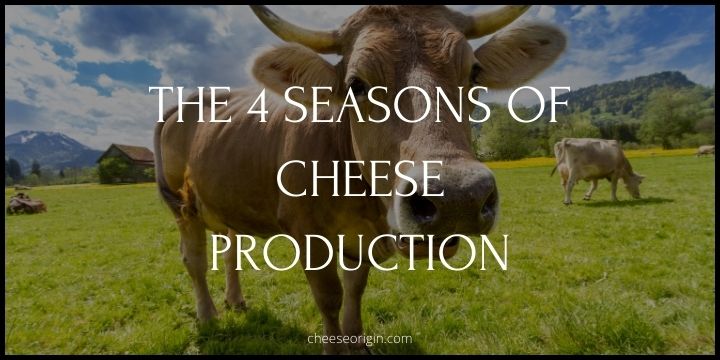The 4 Seasons of Cheese Production (CLIMATES)

Seasons and climates are key factors in cheese manufacturing in regards to the way aromas develop.
Each season have different diet and with each change in diet, the composition of the milk changes too.
| Season | Brief Description |
|---|---|
| Spring | Mountain cheese made in Spring are produced with milk from herds grazing on very moist pasture with an absence of aromatic herbs and flowers. |
| Summer | Herds enjoy more abundant and varied diets: their milk is more aromatic and cheeses they product have better ripening potential. |
| Autumn/Fall | Herds return from the mountains and, even though the grass is less nutritious, the gentle climate is conducive to the production of very interesting cheeses. |
| Winter | Animals return to the barn and are fed hay (dried summer grasses) and cereals (especially corn). It is possible to find delicious winter cheeses whose flavors develop twelve to twenty-four months later. |
Also read: 4 Common Types of Animal’s Milk Used to Make Cheese
Spring
Spring is a time of abundance.
Even though the grass is not high yet, it is still tender, rich in carbohydrates and low in cellulose, which leads to dietary supplements in fibers and magnesium, using dry forage to satisfy ruminants’ natural needs.
In Spring, dairy animals such as cows, goats, and sheep supply an abundance of rich and fragrant milk..
After calving, milk yields are at their peak and tradition & industrial production is at is optimum output capacity.
Cheese caves are filed with cheeses and the affineurs responsible for maturing them wash and rub soft surfaces and turn the wheels to drain them.
Did you know?
Spring cheeses contain more water and are thus creamier than in the fall and in winter.
Summer
Summer milk is the best: at the end of lactation the animal’s milk is full of butterfat and rich in proteins.
There are plenty of grasses and the pasture flora of wild flowers like:
- Gentian,
- Blue thistle
- Broom
And aromatic herbs like:
- Thyme
- Rosemary
Give milk their subtle aromas, so apparent in fresh cheeses like Fontainebleau, Jonchée, and Brousse du Rove, with their delicate flavors.
Nevertheless, if the summer weather is too hot or dry, the grasses tend to lose their nutritional value which lead to a decreased milk yield.
Recommended read: The Amount of Milk Required to Make Cheese
On the other hand, a rainy summer engorges the grass with water bringing milk in abundance but with a lower content of milk solids, especially proteins.
In storm periods, the milk becomes sharper in taste, making cheese rinds tighter and interiors less creamy.
Also read: Should You Eat Cheese Rind?
Autumn / Fall
Autumn is when herds and flocks return to their barns or folds and also the time when lactation ceases for many animals.
The grounds is dry and pasture inadequate. Therefore, to meet dairy animals’ needs, their diet has to be supplemented with dry forage, providing fiber and magnesium as in the Spring.
Low milk production yields seasonal cheeses such as Vacherin Mont d’Or and Morbier.
Winter
A transition period for many cheeses, winter is when animals return to the barns where they are fed hay and silage.
This is also the time when animals’ feeding is closely monitored to ensure the quality of the milk.
A cheese produced in winter has a different flavor and color to a cheese produced in the summer and vice versa.
Some connoisseurs and purists will only eat cheese produced with summer milk, but winter milk is still incredibly good.
At the end of the day, hay is made up of dried summer grass which gives milk its distinct aroma and thus capable of producing delicious cheeses nonetheless.
How Many Days Are in a Lactation Cycle?
| Cows | 305 days (approx.) |
| Goats | 284 days (approx.) |
| Sheep | 100 days (approx.) |
The Demand of Goat’s Cheese During the Holiday Festive Season
The season of goat’s cheese runs from late spring to early autumn, a period when the flavor is at its finest.
Unfortunately, we live in a consumer society that demands a constant supply of goods throughout all seasons.
As a result, some manufacturers and producers alter the goats’ natural lactation cycle with hormone injections and light, or use frozen curds.
Articles You Might Be Interested:





